Wheat Plunges and Corn Gains in July WASDE Report

Wheat Plunges and Corn Gains in July WASDE Report
Agricultural commodity prices reacted to the data, which threw some curveballs
- Corn prices rallied as the WASDE report forces short covering.
- Soybean prices dropped despite reductions in ending stocks.
- Wheat prices sold off on an increase in production and inventory.
The United States Department of Agriculture (USDA) today released its July world agricultural supply and demand estimates (WASDE). Agricultural commodity prices reacted to the data, which threw some curveballs, compared to last month’s WASDE and analysts’ expectations.
Corn shorts continue to cover after WASDE reduces U.S. corn ending stocks
Corn prices initially rallied after the WASDE report crossed the wires, with the projection for 2024/25, new crop, ending stocks falling to 2,097 million bushels vs. an expected estimate of 2,300 million bushels. Feed and residual use and export figures driving the reduction in ending stocks from higher total use. Ending stocks for 2023/24, old crop, came in below expectations as well.
Prices collapsed in June, falling nearly 9%—the biggest monthly decline since June 2023. The declines came amid signs of a supply glut for corn amid improving crop conditions in the United States. Brazil raised its crop estimates for corn this week, adding to selling pressure.
Speculators haven’t been shy about shorting the crop. Last Friday’s Commitments of Traders (COT) report showed a 19,161 increase in short trades on corn among non-commercial traders, otherwise known as speculators. That drove the total short position to 531,881, including options, making it the largest since February.
The price drops over the last few weeks likely put most of those shorts in profitable positions. Those shorts likely decided to cover some of their positions once they saw the WASDE figures. Today’s COT report will cross the wires at 3:30 p.m. EDT and will unveil positioning data up until July 9. The report will likely show some short covering because of corn’s 4.2% drop on July 8, the largest daily percentage decline since June 2023.
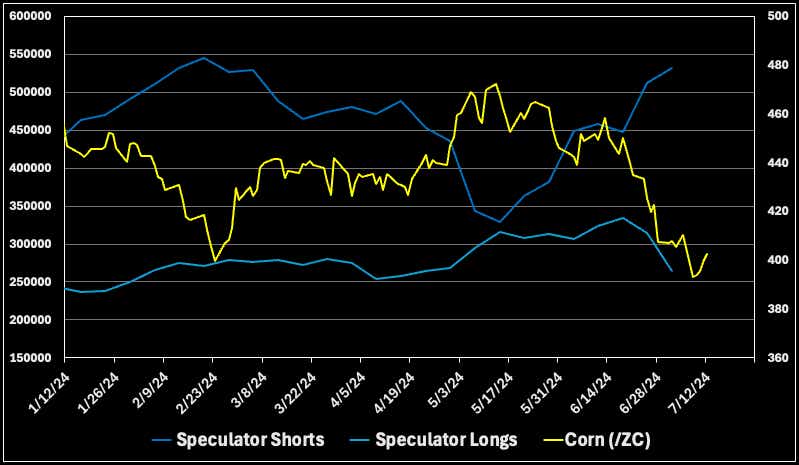
Corn technical analysis
Corn prices remain vulnerable on a technical basis, with prices failing intraday at the nine-day exponential moving average (EMA). Prices haven’t closed above the level since June 13. Oversold conditions may continue if traders can’t breach the EMA, although the moving average convergence/divergence (MACD) shows signs of a potential bottom. The risk to the downside would be breaking the July swing low at 390.75.
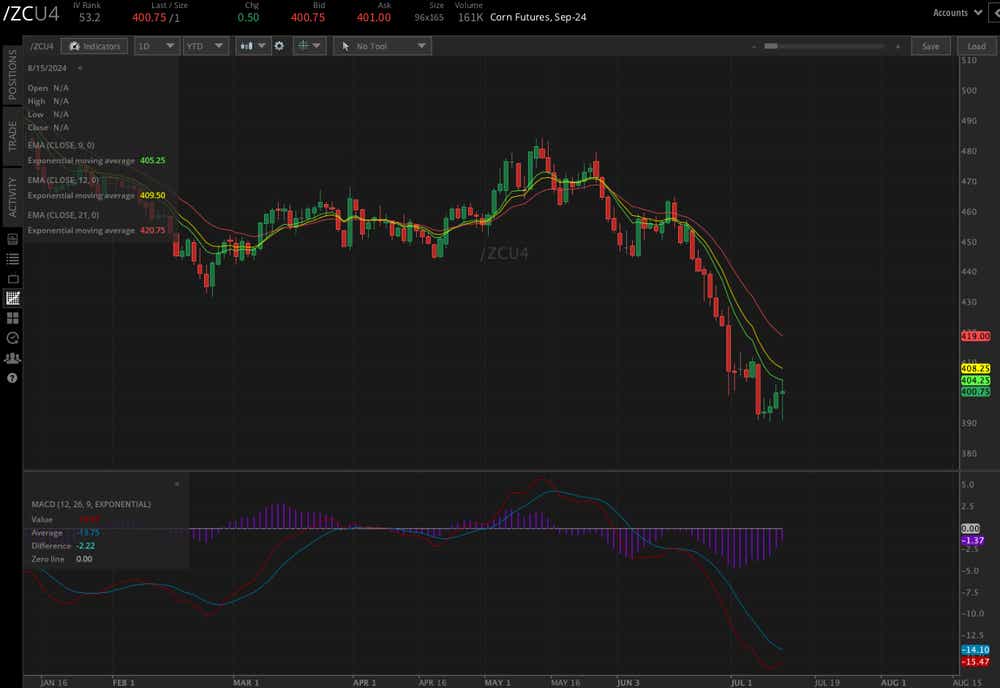
Soybeans fall as ending stocks fail to impress traders
U.S. soybean ending stocks fell to 435 million bushels for 2024/25 on a drop in production to 4,435 million bushels and a decrease in the old crop ending stocks. Analysts expected softer production numbers at 4,400 million and ending stocks of 449 million bushels, although some estimates saw ending stocks as low as 350 million bushels. At face value, the report was bullish for soybeans but apparently not bullish enough for traders.
Speculators were overweighted to the short side going into the report, with speculator shorts increasing by 6,203 contracts, including options, in last Friday’s commitments of traders (COT) report. The report obviously didn’t offer enough for those shorts to cover despite most positions likely yielding a profit, given that soybeans are down nearly 5% this week.
Soybeans technical analysis
Soybean prices are trading into new lows for the August contract (/ZSQ4). On a continuous contract basis, prices are at the lowest since late 2020. There aren’t clean levels of support on the chart, at least not close by. Prices would have to fall another 30% to reach the base formed near 830 in 2020. That said, soybeans remain at risk on a technical basis. The 1,000-level could offer some psychological support and incentivize shorts to take profits but that would require another 6% of declines.
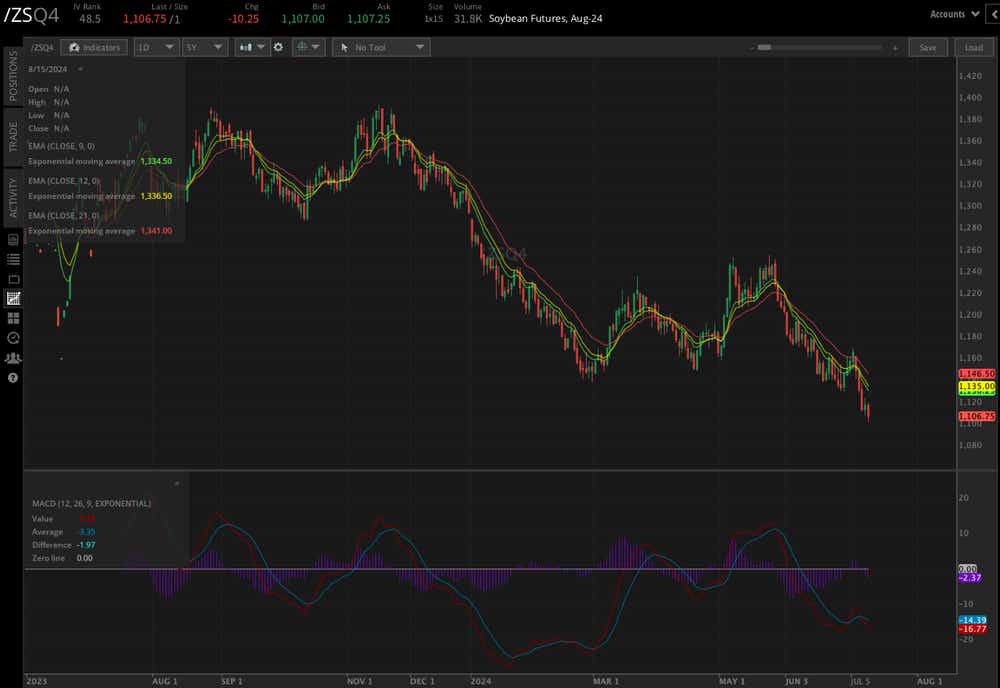
Wheat sinks on bearish WASDE figures
Wheat prices collapsed after the report, which showed that U.S. ending stocks at 856 million bushels, a substantial increase from June’s 758 million bushels. Traders expected ending stocks at 788 million bushels. Production rose to 2,008 million bushels from 1,875 and supply rose to 2,815 million bushels. The production increase resulted from improvements to harvested area and yields. That was too much to overcome an increase in exports.
Active investors rushed to sell the crop, which is now projected to be the largest in the last five years. The 2024/25 season-average farm price was slashed by $0.80 to $5.70 per bushel. Outside the United States, Canada and Pakistan helped to increase the global wheat beginning stocks.
Speculators are heavy on short positions in soft red winter (SRW) wheat futures—the underlying commodity for Chicago wheat futures (/ZW). Last Friday’s COT showed a larger increase in long speculators, however, which points to a potential shift in the overall net short position. The March swing low at 550 may incentivize shorts to take profits if reached. Traders started selling wheat aggressively in June as harvesting progressed ahead of expectations.
Wheat technical analysis
Wheat prices are near the March swing low at 550, a technical level that may offer some support. Yesterday’s trading saw traders push prices above the nine-day and 12-day exponential moving averages (EMAs) before closing lower. A retracement would likely face the same selling pressure. The best hope for bulls is to establish a base at 550, which could force some shorts to exit the market.
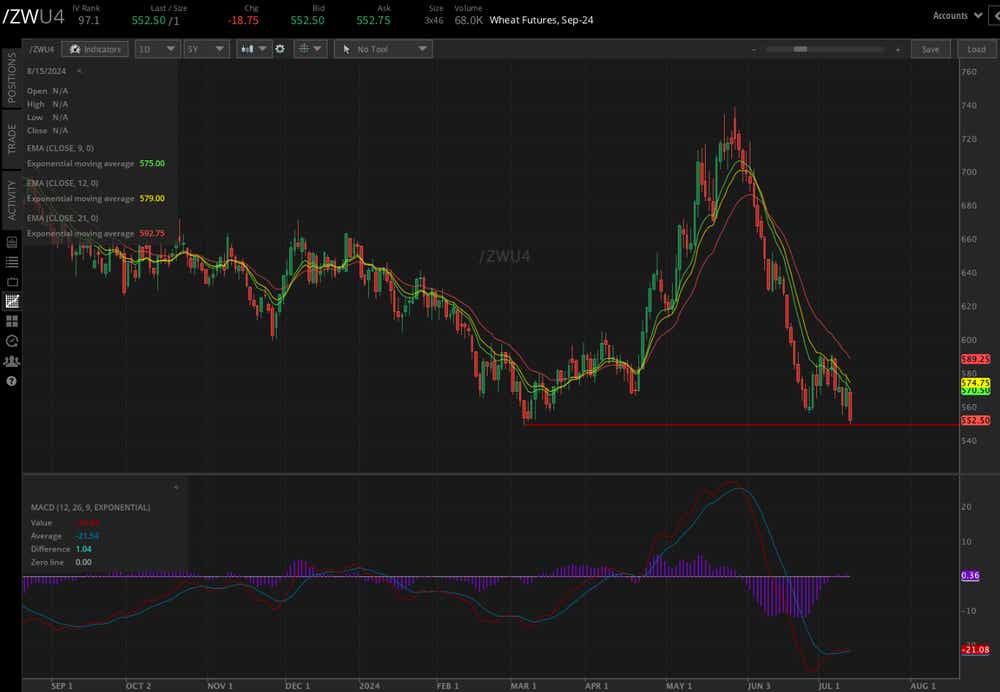
Trading corn, soybeans and wheat
Options traders have plenty of volatility in the futures market in corn, soybeans and wheat, but wheat is offering bigger expected moves comparatively. The September wheat contract (/ZWU4) is trading with an implied volatility rank (IVR) of 97.1 and the August 23 expiration shows an expected move of +/- 41.06 points.
For active investors who believe the March swing low will hold, selling a put spread with the short put at the 40 delta 540 and long put at 535 offers a premium of 112.50 and a max loss of 137.50 with a probability of profit (POP) of 60%.
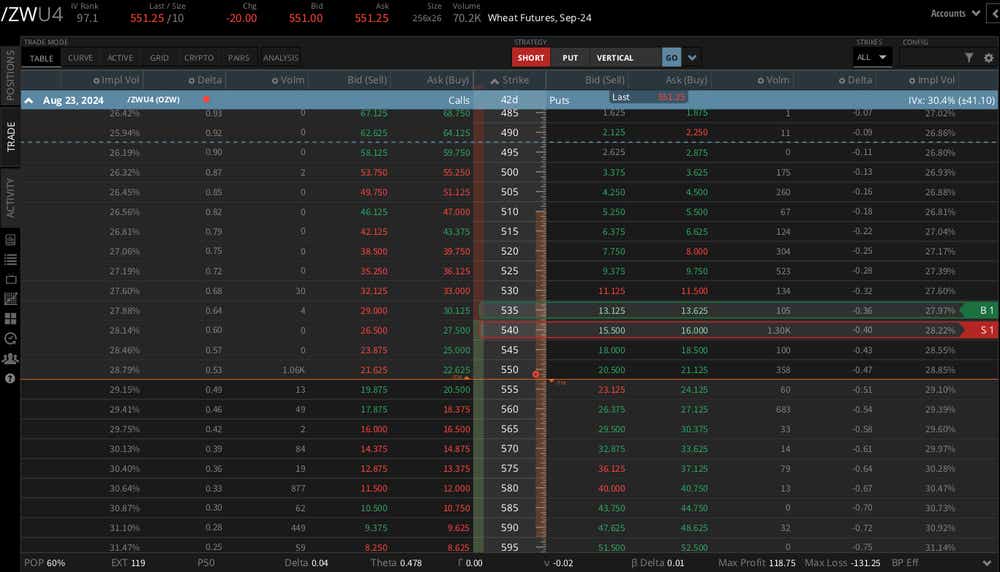
Thomas Westwater, a tastylive financial writer and analyst, has eight years of markets and trading experience. @fxwestwater
For live daily programming, market news and commentary, visit tastylive or the YouTube channels tastylive (for options traders), and tastyliveTrending for stocks, futures, forex & macro.
Trade with a better broker, open a tastytrade account today. tastylive, Inc. and tastytrade, Inc. are separate but affiliated companies.
Options involve risk and are not suitable for all investors. Please read Characteristics and Risks of Standardized Options before deciding to invest in options.